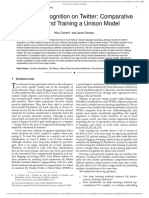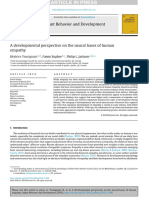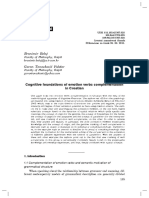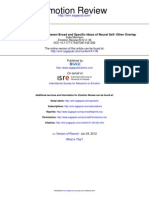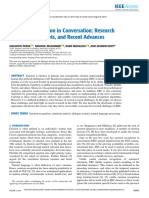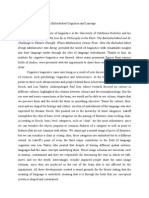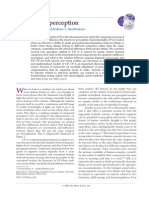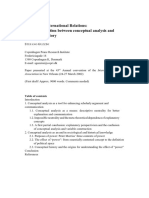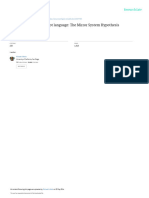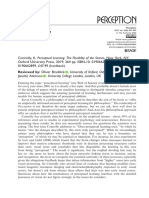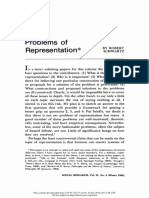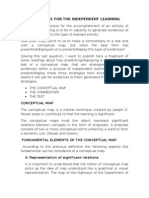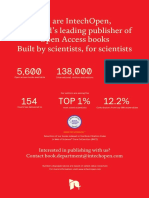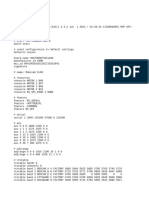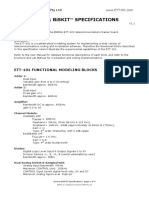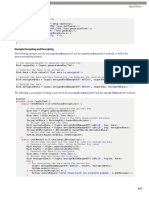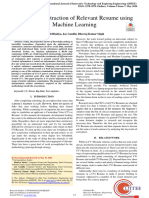Semeraro Et Al. 2021 - PyPlutchnik Options To Represent
Semeraro Et Al. 2021 - PyPlutchnik Options To Represent
Uploaded by
Mercedes Castro-NuñoCopyright:
Available Formats
Semeraro Et Al. 2021 - PyPlutchnik Options To Represent
Semeraro Et Al. 2021 - PyPlutchnik Options To Represent
Uploaded by
Mercedes Castro-NuñoOriginal Title
Copyright
Available Formats
Share this document
Did you find this document useful?
Is this content inappropriate?
Copyright:
Available Formats
Semeraro Et Al. 2021 - PyPlutchnik Options To Represent
Semeraro Et Al. 2021 - PyPlutchnik Options To Represent
Uploaded by
Mercedes Castro-NuñoCopyright:
Available Formats
PLOS ONE
RESEARCH ARTICLE
PyPlutchik: Visualising and comparing
emotion-annotated corpora
Alfonso Semeraro*, Salvatore Vilella ID, Giancarlo Ruffo
Department of Computer Science, University of Turin, Turin, Italy
* alfonso.semeraro@unito.it
a1111111111 Abstract
a1111111111
a1111111111 The increasing availability of textual corpora and data fetched from social networks is fuel-
a1111111111 ling a huge production of works based on the model proposed by psychologist Robert Plu-
a1111111111 tchik, often referred simply as the “Plutchik Wheel”. Related researches range from
annotation tasks description to emotions detection tools. Visualisation of such emotions is
traditionally carried out using the most popular layouts, as bar plots or tables, which are how-
ever sub-optimal. The classic representation of the Plutchik’s wheel follows the principles of
OPEN ACCESS proximity and opposition between pairs of emotions: spatial proximity in this model is also a
Citation: Semeraro A, Vilella S, Ruffo G (2021) semantic proximity, as adjacent emotions elicit a complex emotion (a primary dyad) when
PyPlutchik: Visualising and comparing emotion- triggered together; spatial opposition is a semantic opposition as well, as positive emotions
annotated corpora. PLoS ONE 16(9): e0256503.
are opposite to negative emotions. The most common layouts fail to preserve both features,
https://doi.org/10.1371/journal.pone.0256503
not to mention the need of visually allowing comparisons between different corpora in a
Editor: Christopher M. Danforth, University of
blink of an eye, that is hard with basic design solutions. We introduce PyPlutchik the
Vermont, UNITED STATES
Pyplutchik package is available as a Github repository (http://github.com/alfonsosemeraro/
Received: June 8, 2021
pyplutchik) or through the installation commands pip or conda. For any enquiry about usage
Accepted: August 6, 2021 or installation feel free to contact the corresponding author, a Python module specifically
Published: September 1, 2021 designed for the visualisation of Plutchik’s emotions in texts or in corpora. PyPlutchik draws
Peer Review History: PLOS recognizes the the Plutchik’s flower with each emotion petal sized after how much that emotion is detected
benefits of transparency in the peer review or annotated in the corpus, also representing three degrees of intensity for each of them.
process; therefore, we enable the publication of Notably, PyPlutchik allows users to display also primary, secondary, tertiary and opposite
all of the content of peer review and author
dyads in a compact, intuitive way. We substantiate our claim that PyPlutchik outperforms
responses alongside final, published articles. The
editorial history of this article is available here: other classic visualisations when displaying Plutchik emotions and we showcase a few
https://doi.org/10.1371/journal.pone.0256503 examples that display our module’s most compelling features.
Copyright: © 2021 Semeraro et al. This is an open
access article distributed under the terms of the
Creative Commons Attribution License, which
permits unrestricted use, distribution, and
reproduction in any medium, provided the original
author and source are credited. 1 Introduction
Data Availability Statement: All data is freely The recent availability of massive textual corpora has enhanced an extensive research over the
available and the plots can be easily reproduced,
emotional dimension underlying human-produced texts. Sentences, conversations, posts,
we do not have any special access to the data. The
data is properly referenced in the bibliography, the
tweets and many other pieces of text can be labelled according to a variety of schemes, that
links are the following: SSEC data: http://www. refer to as many psychological theoretical frameworks. Such frameworks are commonly
romanklinger.de/ssec/ Amazon data: https:// divided into categorical models [1–4], based on a finite set of labels, and dimensional models
PLOS ONE | https://doi.org/10.1371/journal.pone.0256503 September 1, 2021 1 / 24
PLOS ONE PyPlutchik: Visualising and comparing emotion-annotated corpora
jmcauley.ucsd.edu/data/amazon/ IMDB data: [5, 6], that position data points as continuous values in an N-dimensional vector space of emo-
https://www.kaggle.com/omarhanyy/imdb-top- tions. One of the most famous dimensional models is Russel’s circumplex model of emotions
1000 We added the scripts to reproduce the plots
[7]. Russel’s model posits that affect states are defined by dimensions that are not independent:
to the Github repository.(https://github.com/
alfonsosemeraro/pyplutchik). emotions can be represented as points in a space whose main orthogonal axes represent their
degree of arousal and of pleasure/displeasure. According to Russel, the full spectrum of emo-
Funding: The author(s) received no specific
tions can be meaningfully placed along the resulting circumference. Russel is not the first
funding for this work.
scholar to use a circular layout to represent emotions (for instance, it was already used in [8]):
Competing interests: The authors have declared indeed, this kind of circumplex representation became very popular over time, since it is suit-
that no competing interests exist.
able to spatially represent emotions on a continuous space.
The cultural variation of emotions has also been studied. This is a crucial factor to take into
account when classifying emotions: intuitively, the categories themselves can radically change
depending on the cultural background [9]. This is also valid with respect to how the annotator
perceives the emotions in a text and, if the annotated data is then used to train a classifier, it
can introduce a bias in the model. The nomenclature of emotions, their meanings and the rela-
tions of words to emotion concepts depend on the social frameworks in which we are born
and raised: therefore, cultural variation can significantly impact this kind of analysis. In this
regard, in [10] the authors estimate emotion semantics across a sample of almost 2500 spoken
languages, finding high variability in the meaning of emotion terms, but also evidence of a uni-
versal structure in the categorization of emotions. Following different methodological
approaches, similar results were previously obtained in [11].
Regardless of their categorical or dimensional nature, the emotional models provide a com-
plex and multifaceted characterisation of emotions, which often necessitates dedicated and
innovative ways to visualise them. This is the case of Plutchik’s model of emotions [12], a cate-
gorical model based on 8 labels (Joy, Trust, Fear, Surprise, Sadness, Disgust, Anger and Antici-
pation). According to the model, emotions are displayed in a flower-shaped representation,
famously known as Plutchik’s wheel, which has become since then a classic reference in this
domain. The model, that displays emotions in this circumplex-like representation and that is
described in detail in Sec. 2, leverages the disposition of the petals around the wheel to high-
light the similar (or opposite) flavour of the emotions, as well as how similar emotions, placed
in the same “hemisphere” of the wheel, can combine into primary, secondary and tertiary
dyads, depending on how many petals away they are located on the flower.
It is clear that such a complex and elaborated solution plays a central role in defining the
model itself. Still, as detailed in Sec. 2, many studies that resort to Plutchik’s model display
their results using standard data visualisation layouts, such as bar plots, tables, pie charts and
scatter plots, most likely due to the lack of an easy, plug-and-play implementation of the Plu-
tchik’s wheel.
On these premises, we argue that the most common layouts fail to preserve the characteris-
ing features of Plutchik’s model, not to mention the need of visually allowing comparisons
between different corpora at a glance, that is hard with basic design solutions. We contribute
to fill the gap in the data visualisation tools by introducing PyPlucthik, a Python module for
visualising texts and corpora annotated according to the Plutchik’s model of emotions. Given
the preeminence of Python as a programming language in the field of data science and, partic-
ularly, in the area of Natural Language Processing (NLP), we believe that the scientific commu-
nity will benefit from a ready-to-use Python tool to fulfil this particular need. Of course, other
packages and libraries may be released for other languages in the future.
PyPlutchik provides an off-the-shelf Python implementation of the Plutchik’s wheel. Each
petal of the flower is sized after the amount of the correspondent emotion in the corpus: the
more traces of an emotion are detected in a corpus, the bigger the petal is drawn. Along with
PLOS ONE | https://doi.org/10.1371/journal.pone.0256503 September 1, 2021 2 / 24
PLOS ONE PyPlutchik: Visualising and comparing emotion-annotated corpora
Table 1. Plutchik’s 8 basic emotions with 3 degrees of intensity each. Emotions are commonly referred as the middle
intensity degree ones.
Lower intensity Emotion Higher intensity
Annoyance Anger Rage
Interest Anticipation Vigilance
Serenity Joy Ecstasy
Acceptance Trust Admiration
Apprehension Fear Terror
Distraction Surprise Amazement
Pensiveness Sadness Grief
Boredom Disgust Loathing
https://doi.org/10.1371/journal.pone.0256503.t001
the 8 basic emotions, PyPlutchik displays also three degrees of intensity for each emotion (see
Table 1).
PyPlutchik is built on top of Python data visualisation library matplotlib [13], and it is fully
scriptable, hence it can be used for representing the emotion annotation of single texts (e.g. for
a single tweet), as well as of entire corpora (e.g. a collection of tweets), offering a tool for a
proper representation of such annotated texts, which at the best of our knowledge was missing.
The two-dimensional Plutchik’s wheel is immediately recognisable, but it is a mere qualitative
illustration. PyPlutchik introduces a quantitative dimension to this representation, making it a
tool suitable for representing how much an emotion is detected in a corpus. The module
accepts as an input a score si 2 [0, 1] for each of the 24 i emotions in the model (8 basics emo-
tions, 3 degrees of intensity each). Please note that, since the same text cannot express two dif-
ferent degrees of the same emotion, the sum of all the scores of the emotions belonging to the
same branch must be less than or equal to 1. Each emotion petal is then sized according to this
score. In Fig 1 we can see an example of the versatility of the PyPlutchik representation of the
annotated emotions: in (i) we see a pseudo-text in which only Joy, Trust and Sadness have been
detected; in (ii) for each emotion, the percentage of pseudo-texts in a pseudo-corpus that show
that emotion; finally (iii) contains a detail of (ii), where the three degrees of intensity have
been annotated separately.
Most importantly, PyPlutchik is respectful of the original spatial and aesthetic features of
the wheel of emotions intended by its author. The colour code has been hard-coded in the
Fig 1. A three fold showcase of our visualisation tool on synthetic data: (i) a text where only Joy, Trust and Sadness have been
detected; (ii) a corpus of many texts. Each petal is sized after the amount of items in the corpus that show that emotion in; (iii) same
corpus as (ii), but higher and lower degrees of intensity of each emotion are expressed.
https://doi.org/10.1371/journal.pone.0256503.g001
PLOS ONE | https://doi.org/10.1371/journal.pone.0256503 September 1, 2021 3 / 24
PLOS ONE PyPlutchik: Visualising and comparing emotion-annotated corpora
module, as it is a distinctive feature of the wheel that belongs to collective imagination. Spatial
distribution of the emotion is also a standard, non customisable feature, as the displacement of
each petal of the flower is non arbitrary, because it reflects a semantic proximity of close emo-
tions, and a semantic contrariety of opposite emotions (see Sec. 2).
Representing emotions detected in texts can be hard without a proper tool, but it is a need
for the many scientists that work on text and emotions. A great variety of newly available digi-
tal text has been explored in order to uncover emotional patterns; the necessity of a handy
instrument to easily display such information is still unsatisfied.
In the following sections, after introducing the reader to the topic of emotion models and
their applications in corpora annotation, we will focus on the Plutchik’s emotion model and
the current state of the art of its representations. A detailed technical explanation of the
PyPlutchik module will follow, with several use cases on a wide range of datasets to help sub-
stantiating our claim that PyPlutchik outperforms other classic visualisations.
2 Related work
2.1 Visualising textual data
Visualising quantitative information associated to textual data might not be an easy task, due
to “the categorical nature of text and its high dimensionality, that makes it very challenging to
display graphically” [14]. Several scientific areas leverage visualisations techniques to extract
meaning from texts, such as digital humanities [15] or social media analysis [16].
Textual data visualisations often usually provide tools for literacy and citation analysis; e.g.,
PhraseNet [17], Word Tree [18], Web Seer http://hint.fm/seer/, and Themail [19] introduced
many different ways to generate visual overviews of unstructured texts. Many of these projects
were connected to ManyEyes, that was launched in 2007 by Viégas, Wattenberg, and al. [20] at
IBM, and closed in 2015 to be included in IBM Analytics. ManyEyes was designed as a web
based community where users (mainly data analysts and visualisation designers) could upload
their data to establish conversations with other users. The ambitious goal was to create a social
style of data analysis so that visualisations can be tools to create collaboration and carry on
discussions.
Nevertheless, all of these classic visualisation tools did not allow the exploration of more
advanced textual semantic features that can be analysed nowadays due to the numerous devel-
opments of Natural Language Processing techniques; nowadays, it exists a good number of
software suites—such as Tableau, Microsoft PowerBI or Datawrapper, just to mention a few—
that give the users a chance to create very interesting, eye-catching and often complex visuali-
zations. They all adopt a graphical user interface, with all the pros and cons that usually come
with it: an intuitive and fast way to realise the majority of the most common layouts, but likely
less flexible when it comes to create a more personalised visualisation. On the other hand, pro-
gramming libraries and modules—such as Python’s Matplotlib [13], Plotly [21] and Bokeh
[22], or D3.js [23] in Javascript allow the users to create freely their own visualisations, though
with a much steeper learning curve for those who are not familiar with these technologies.
The recent advancements in text technologies have enabled researchers and professional
analysts with new tools to find more complex patterns in textual data. Algorithms for topic
detection, sentiment analysis, stance detection and emotion detection allow us to convert very
large amounts of textual data to actionable knowledge; still, the outputs of such algorithms can
be too hard to consume if not with an appropriate data visualisation [24]. During the last
decade, many works have been carried out to fill this gap in the areas of (hierarchical) topic
visualisation [25–28], sentiment visualisation (a comprehensive survey can be found in [29]),
online hate speech detection [30], stance detection [31] and many more.
PLOS ONE | https://doi.org/10.1371/journal.pone.0256503 September 1, 2021 4 / 24
PLOS ONE PyPlutchik: Visualising and comparing emotion-annotated corpora
Our work lies within the domain of visualisation of emotions in texts, as we propose a novel
Python implementation of Plutchik’s wheel of emotions.
2.2 Understanding emotions from texts
In the last few years, many digital text sources such as social media, digital libraries or televi-
sion transcripts have been exploited for emotion-based analyses. To mention just a few exam-
ples, researchers have studied the display of emotions in online social networks like Twitter
[32–35] and Facebook [36–38], in literature corpora [39, 40], in television conversations [41],
in dialogues excerpts from call centres conversations [42], in human-human video conversa-
tions [43]. In [44] the authors, after developing a methodology (the so-called TFMN, textual
forma mentis networks) that exploits complex networks to extract the semantic framework of
concepts from texts, resort to the Plutchik’s model to analyse it.
Among categorical emotion models, Plutchik’s wheel of emotions is one of the most popu-
lar. Categorical (or discrete) emotions model root to the works of Paul Ekman [1], who first
recognised six basic emotions universal to the human kind (Anger, Disgust, Fear, Happiness,
Sadness, Surprise). Although basicality of emotions is debated [45], categorical emotions are
very popular in natural language processing research, because of their practicality in annota-
tion. In recent years many other categorical emotion models have been proposed, each with a
distinctive set of basic emotions: the model first proposed by James [2] presents 6 basic emo-
tions, Plutchik’s model 8, Izard’s model [3] 12, Lazarus et al. [4] model 15, Ekman’s extended
model [46] 18, Cowen et al. [47] 27. Parrott [48] proposed a tree-structured model with 6 basic
emotions on a first level, 25 on a second level and more than one hundred on a third level. Sus-
anto et al. in [49] propose a revisited version of the hourglass of emotions by Cambria et al.
[50], an interesting model that moves from Plutchik’s one by positioning emotions in an hour-
glass-shaped design.
However, annotation of big corpora of texts is easier if labels are in a small number, clearly
distinct from each other; on the other hand, a categorical classification of complex human
emotions into a handful of basic labels may be limiting.
Plutchik’s model’s popularity is probably due to a peculiar characteristic. In its wheel of
emotions, there are 8 basic emotions (Joy, Trust, Fear, Surprise, Sadness, Disgust, Anger and
Anticipation) with three intensity degrees each, as shown in Table 1 and in Fig 2. Even if each
emotion is a category on its own, emotions are related each other by their spatial displacement.
In fact, four emotions (Anger, Anticipation, Joy, Trust) are respectively opposed to the other
four (Fear, Surprise, Sadness, Disgust); for instance, Joy is the opposite of Sadness, hence it is
displayed symmetrically with respect to the centre of the wheel. When elicited together, two
emotions raise a dyad, a complex emotion. Dyads are divided into primary (when triggered by
two adjacent emotions), secondary (when triggered by two emotions that are 2 petals away),
tertiary (when triggered by two emotions that are 3 petals away) and opposite (when triggered
by opposite emotions). A comprehensive diagram of emotion combination and elicited dyads
is represented in Fig 3. This mechanism allows to annotate a basic set of only 8 emotions,
while triggering eventually up to 28 more complex nuances, that better map the complexity of
human emotions. When representing corpora annotated following Plutchik’s model, it is
important then to highlight spatial adjacency or spatial opposition of emotions in a graphical
way. We will refer to these feature as semantic proximity and semantic opposition of two
emotions.
From a data visualisation point of view, PyPlutchik’s closest relatives can be found in bar
plots, radar plots and Windrose diagrams. Bar plots correctly display the quantitative represen-
tation of categorical data, while radar plots (also known as spider plot) correctly displace
PLOS ONE | https://doi.org/10.1371/journal.pone.0256503 September 1, 2021 5 / 24
PLOS ONE PyPlutchik: Visualising and comparing emotion-annotated corpora
Fig 2. Plutchik’s wheel of emotions. Each petal is partitioned in three degrees of intensity, from the most intense (the
most internal section) to the least intense (the most external section).
https://doi.org/10.1371/journal.pone.0256503.g002
elements in a polar coordinate system, close to the original Plutchik’s one. Windrose diagrams
combine both advantages, displaying categorical data on a polar coordinate system. PyPlutchik
is inspired to this representation, and it adapts this idea to the collective imagination of Plu-
tchik’s wheel of emotion graphical picture.
2.3 Representing Plutchik’s emotions wheel
If we skim through the related literature, we notice that many papers needed to display the dis-
tribution of emotions in a corpus, and without a dedicated tool they all settled for a practical
but sub-optimal solution. In some way, each of the following representations does not respect
the standard spatial or aesthetic features of Plutchik’s wheel of emotions:
• Tables, as used in [51–56]. Tables are a practical way to communicate exact amounts in an
unambiguous way. However, tables are not a proper graphical display, so they miss all the
features of the original wheel of emotions: there is not a proper colour code and both seman-
tic proximity and semantic opposition are dismantled. Confronted with a plot, texts are
harder to read: plots deliver the same information earlier and easier.
• Bar plots, as used in [57–63]. Bar plots are a traditional option to allow numerical compari-
sons across categories. In this domain, each bar would represent how many times a emotion
is shown in a given corpus. However, bar plots are sub-optimal for two reasons. Firstly, the
spatial displacement of the bars does not reflect semantic opposition of two emotions, that
are opposites in the Plutchik’s wheel. Secondly, Plutchik’s wheel is circular, meaning that
there is a semantic proximity between the first and the last of the 8 emotions branches,
PLOS ONE | https://doi.org/10.1371/journal.pone.0256503 September 1, 2021 6 / 24
PLOS ONE PyPlutchik: Visualising and comparing emotion-annotated corpora
Fig 3. Diagram of Plutchik’s dyads. When two emotions are elicited together, they trigger the corresponding primary
dyad if they are just one petal apart, a secondary dyad if they are two petal distant each other, a tertiary dyad if they are
three petal distant, an opposite dyad if they are on the opposite side of the flower.
https://doi.org/10.1371/journal.pone.0256503.g003
which is not represented in a bar plot. PyPlutchik preserves both semantic opposition and
semantic proximity: the mass distribution of the ink in Fig 14(i and vi), for instance, imme-
diately communicates of a positive corpus, as positive emotions are way more expressed
than their opposites.
• Pie charts, as used in [55, 64–67]. Pie charts are a better approximation of the Plutchik’s
wheel, as they respect the colour code and they almost respect the spatial displacement of
emotions. However, the actual displacement may depend on the emotion distribution: with
a skewed distribution toward one or two emotions, all the remaining sectors may be shrunk
and translated to a different position. Pie charts do not guarantee a correct spatial position-
ing of each category. There is also an underlying conceptual flaw in pie charts: they do not
handle well items annotated with more than one tag, in this case texts annotated with more
than one emotion. In a pie chart, the sum of the sectors’ sizes must equal the number of all
the items; each sector would count how many items fall into a category. If multiple annota-
tion on the same item are allowed, the overall sum of sectors’ sizes will exceed the number of
actual items in the corpus. Null-annotated items, i.e. those without a noticeable emotion
within, must be represented as a ninth, neutral sector. PyPlutchik handles multi-annotated
and null-annotated items: for instance, Fig 1(ii) shows a pseudo-corpus where Anger and
Disgust both are valued one, because they appear in 100% of the pseudo-texts within. Fig 1(i)
shows a text with several emotions missing.
• Heatmaps, as used in [68, 69]. Both papers coded the intensity of the 8 basic emotions
depending on a second variable, respectively time and principal components of a vectorial
representation of texts. Although heatmaps naturally fit the idea of an intensity score at the
crossroad of two variables, the final display are sub-optimal in both cases, because they fail to
preserve both the Plutchik’s wheel’s colour code and spatial displacement of emotions. As
described in Sect. 3, PyPlutchik can be easily scripted for reproducing small-multiples. In
PLOS ONE | https://doi.org/10.1371/journal.pone.0256503 September 1, 2021 7 / 24
PLOS ONE PyPlutchik: Visualising and comparing emotion-annotated corpora
Sect. 5 we provide an example of a small-multiple, displaying the evolution of the distribu-
tion of emotions in a corpus over time.
• Scatter plots, as used in [70]. Scatter plot are intended to display data points in a two- or
three-dimensional space, where each axis maps a continuous variable. In [70], x-axis repre-
sents the rank of each emotion on each of the three corpora they analyse, thus producing a
descending sorting of emotion labels. This choice was probably made in order to have three
descending, more readable series of scatters on the plot. However, this representation breaks
both the colour code and the spatial displacement of emotions. PyPlutchik can be easily
scripted for a side-by-side comparison of more than one corpus (see Sect. 3), allowing read-
ers to immediately grasp high level discrepancies.
• Line plots, as used in [71]. As well as scatter plots, line plots are appropriate for displaying a
trend in a two-dimensional space, where each dimension maps a continuous variable. It is
not the case of discrete emotions. Authors plotted the distribution of each emotion over time
as a separate line. They managed to colour each line with the corresponding colour in the
Plutchik’s wheel, reporting the colour code in a separate legend. As stated before in similar
cases, this representation breaks the semantic proximity (opposition) of close (opposite)
emotions. Again, in Sect. 3 we provide details about how to script PyPlutchik to produce a
small-multiple plot, while in Sec. 5 we showcase the distribution of emotions by time on a
real corpus.
• Radar plots, as used in [72–74]. Radar plots, a.k.a. Circular Column Graphs or Star Graphs,
successfully preserve spatial proximity of emotions. Especially when the radar area is filled
with a non-transparent colour, radars correctly distribute more mass where emotions are
more expressed, giving to the reader an immediate sense of how shifted a corpus is against a
neutral one. However, on a minor note, continuity of lines and shapes do not properly sepa-
rate each emotion as a discrete objects per se. Furthermore, radars do not naturally repro-
duce the right colour code. Lastly, radars are not practical to reproduce stacked values, like
the three degrees of intensity in Fig 1 (i). Of course, all of these minor issues can be
solved with an extension of the basic layout, or also adopting a Nightingale Rose Chart
(also referred as Polar Area Chart or Windrose diagram), as in [35, 75]. However, the main
drawback with radar plots and derivatives is that semantic opposition is lost, and we do
not have a direct way to represents dyads and their occurrences. PyPlutchik, conversely,
has been tailored on the original emotion’s wheel, and it naturally represents both
semantic proximity and opposition, as well as the occurrences of dyads in our corpora
(see Sect. 4).
3 Visualising primary emotions with PyPlutchik
PyPlutchik is designed to be integrated in data visualisation with the Python library matplotlib.
It spans the printable area in a range of [−1.6, 1.6] inches on both axes, taking the space to rep-
resent a petal of maximum length 1, plus the outer labels and the inner white circle. Each petal
overlaps on one of the 8 axis of the polar coordinate system. Four transversal minor grid lines
cross each axis, spaced of 0.2 inches each, making it a visual reference for a quick evaluation of
the petal size and for a comparison between non adjacent petals. Outside the range [0, 1], cor-
responding to each petal, two labels represent the emotion and the associated numerical score.
Colour code is strictly hard-coded, following Plutchik’s wheel of emotions classic
PLOS ONE | https://doi.org/10.1371/journal.pone.0256503 September 1, 2021 8 / 24
PLOS ONE PyPlutchik: Visualising and comparing emotion-annotated corpora
Fig 4. Plutchik’s wheel generated by code on the right. Each entry in the Python dict is a numeric value 2 [0, 1].
https://doi.org/10.1371/journal.pone.0256503.g004
representation. PyPlutchik can be used either to plot only the 8 basic emotions, or to show the
full intensity spectrum of each emotion, assigning three scores for the three intensity levels. In
the latter case, each petal is divided into three sections, with colour intensity decreasing from
the centre. In both cases PyPlutchik accepts as input a dict data structure, with exactly 8 items.
Keys must be the 8 basic emotions names. dict is a natural Python data structure for represent-
ing JSON files, making PyPlutchik an easy choice to display JSONs. In case of basic emotions
only, values in the dict must be numeric 2 [0, 1], while in case of intensity degrees they must
be presented as an iterable of length three, whose entries must sum to maximum 1. Figs 4
and 5 show how straightforward it is to plug a dict into the module to obtain the visualisation.
Furthermore, PyPlutchik can be used to display the occurrences of primary, secondary, and
tertiary dyads in our corpora. This more advanced feature will be described in Sect. 4.
Due to the easy integration with Python basic data structures and the matplotlib library,
PyPlutchik is also completely scriptable to display several plots side by side as small-multiple.
Default font family is sans-serif, and text is printed with light weight and size 15 by default.
However, it is possible to modify these features by the means of the corresponding parameters
(see the documentation the Pyplutchik documentation is available in the Github repository at
https://github.com/alfonsosemeraro/pyplutchik/blob/master/Documentation.md for a com-
prehensive and always up-to-date explanation of parameters and features of the module).
These features can be also changed with standard matplotlib syntax. The polar coordinates
beneath petals and the labels outside can be hidden: this feature leaves only the flower on
screen, improving visibility of small flowers in small-multiple plots. Also the petals aspect can
be modified, by making them thinner or thicker. Fig 6 shows a small-multiple, with hidden
Fig 5. Plutchik’s wheel generated by code on the right. Each entry in the Python dict is a three-sized array, whose
sum must be 2 [0, 1].
https://doi.org/10.1371/journal.pone.0256503.g005
PLOS ONE | https://doi.org/10.1371/journal.pone.0256503 September 1, 2021 9 / 24
PLOS ONE PyPlutchik: Visualising and comparing emotion-annotated corpora
Fig 6. Small-multiple of a series of Plutchik’s wheel built from synthetic data. Polar coordinates beneath the flowers and
labels around have been hidden to improve the immediate readability of the flowers, resulting in a collection of emotional
fingerprints of different corpora.
https://doi.org/10.1371/journal.pone.0256503.g006
polar coordinates and labels, computed on synthetic random data that have been artificially
created only for illustrative purposes. Code for this kind of representation is in the code docu-
mentation, as well as a short overview on the parameters that make possible to reproduce the
aforementioned variations.
As a further customisation option, we allow the user to select a set of petals to be
highlighted. This selective presentation feature follows a focus-plus-context [76] approach to
the need of emphasising those emotions that might be more distinctive, according to the case
under consideration. We chose to apply a focus-plus-context visualisation by filling petals’
areas selectively, without adopting other common techniques, as with fish-eye views [77], in
order to avoid distortions and to preserve the spatial relations between the petals. It is possible
to select a list of main emotions, and to show a colored petal and all three intensity scores for
each emotion in the list, while for the others it will display a grey petal and the cumulative
scores only, also in grey. We showcase this feature in Fig 7 and in the code documentation.
PLOS ONE | https://doi.org/10.1371/journal.pone.0256503 September 1, 2021 10 / 24
PLOS ONE PyPlutchik: Visualising and comparing emotion-annotated corpora
Fig 7. A side-by-side comparison between the synthetic plot of Fig 1(iii) and an almost identical wheel, but with only two emotions highlighted.
We highlighted and displayed the three intensity scores of Anticipation and Joy.
https://doi.org/10.1371/journal.pone.0256503.g007
4 Showing dyads with PyPlutchik
Dyads are a crucial feature in Plutchik’s model. As explained in Sec. 1, the high flexibility of
the model derives also from the spatial disposition of the emotions. Primary emotions can
combine with their direct neighbours, forming primary dyads, or with emotions that are two
or three petals away, forming respectively secondary and tertiary dyads. Opposite dyads can be
formed as well, by combining emotions belonging to opposite petals. This feature dramatically
enriches the spectrum of emotions, beyond the primary ones; enriching the spectrum increases
the complexity of the models, also contributing to mitigate, at least partially, the phenomenon
of cultural variation discussed in Sec. 1. Therefore, a comprehensive visualisation of Plutchik’s
model must offer a way to visualise dyads.
The design of such a feature is non trivial. Indeed, while the flower of primary emotions is
inherent to the model itself, no standard design is provided to visualise dyads. For our imple-
mentation we decided to stick with the flower-shaped graphics, in order not to deviate too
much from the original visualisation philosophy. Examples that show all levels of dyads can be
seen in Figs 14 and 15. While the core of the visual remains the same, a few modifications are
introduced. In more detail:
• the radial axes are progressively rotated by 45 degrees in each level, to enhance the spatial
shift from primary emotions to dyads;
• the petals are two-tone, according to the colours of the primary emotions that define each
dyad;
• a textual annotation in the center gives an indication of what kind of dyad is represented: “1”
for primary dyads, “2” for secondary dyads, “3” for tertiary dyads, “opp.” for opposite dyads.
• while the dyads labels all come in the same colour (default is black), an additional circular
layer has been added in order to visualise the labels and the colours of the primary emotions
that define each dyad.
PLOS ONE | https://doi.org/10.1371/journal.pone.0256503 September 1, 2021 11 / 24
PLOS ONE PyPlutchik: Visualising and comparing emotion-annotated corpora
Fig 8. Primary dyads’ wheel generated by code on the right. Each entry in the Python dict is a numeric value 2 [0, 1].
https://doi.org/10.1371/journal.pone.0256503.g008
This last feature is particularly useful to give the user an immediate sense of the primary
emotions involved in the formation of the dyad. Fig 8 provides an example of the wheel pro-
duced if the user inputs a dict containing primary dyads instead of emotions. PyPlutchik auto-
matically checks for the kind of input wheel and for its coherence: specifically, the module
retrieves an error if the input dictionary contains a mix of emotions from different kind of
dyads, as they cannot be displayed on the same plot. In Fig 9 we show a representation of basic
emotions, primary dyads, secondary dyads, tertiary dyads and opposite dyads, based on syn-
thetic data. This representation easily conveys the full spectrum of emotions and their combi-
nations according to Plutchik’s model, allowing for a quick but in-depth analysis of emotions
detected in a corpus.
5 Case studies
We now showcase some useful examples of data visualisation using PyPlutchik. We argue that
PyPlutchik is more suitable than any other graphical tool to narrate the stories of these exam-
ples, because it is the natural conversion of the original qualitative model to a quantitative
akin, tailored to visually represent occurrences of emotions and dyads in an annotated corpus.
5.1 Amazon office products reviews
As a further use case we exploit a dataset of products review on Amazon [78]. This dataset con-
tains almost 142.8 millions reviews spanning May 1996—July 2014. Products are rated by the
customers on a 1-5 stars scale, along with a textual review. Emotions in these textual reviews
have been annotated using the Python library NRCLex [79], which checks the text against a
lexicon for word-emotion associations; we do not have any ambition of scientific accuracy of
the results, as this example is meant for showcasing our visualisation layouts.
In Fig 10 we plot the average emotion scores in a sample of reviews of office products,
grouped by the star-ratings. We can sense a trend: moving from left to right, i.e. from low-
rates to high-rates products, we see the petals in the top half of the flower slowly growing in
size at the expense of the bottom half petals. The decreasing effect is particularly visible in
Fear, Anger and Disgust.
This visualisation is effective in communicating the increasing satisfaction of the customers;
nevertheless, this improvement is very gradual and can hardly be noticed by comparing to sub-
sequent steps. As we can see from Fig 11(a), it is much more evident if we compare one-star-
rated products to five-star-rated product reviews. The selective presentation feature of our
module (Fig 11(b)) is a good way to enhance this result: it allows to put emphasis on the
PLOS ONE | https://doi.org/10.1371/journal.pone.0256503 September 1, 2021 12 / 24
PLOS ONE PyPlutchik: Visualising and comparing emotion-annotated corpora
Fig 9. Representation of emotions and primary, secondary, tertiary and opposite dyads. The data displayed is
random.
https://doi.org/10.1371/journal.pone.0256503.g009
PLOS ONE | https://doi.org/10.1371/journal.pone.0256503 September 1, 2021 13 / 24
PLOS ONE PyPlutchik: Visualising and comparing emotion-annotated corpora
Fig 10. Average emotion scores in a sample of textual reviews of office products on Amazon. Rating of products goes from one star (worst) to five
(best). On the left, emotions detected in negative reviews (one star), on the right the emotions detected in positive reviews (five star). While positive
emotions stay roughly the same, negative emotions such Anger, Disgust and Fear substantially drop as the ratings get higher.
https://doi.org/10.1371/journal.pone.0256503.g010
desired emotions without losing sight of the others, that are left untouched in their size or
shape but are overshadowed, deprived of their coloured fill.
5.2 Emotions in IMDB movie synopses
In Fig 12 is shown the emotion detected in the short synopses from the top 1000 movies on the
popular website IMDB (Internet Movie Data Base). Data is an excerpt of only four genres
(namely Romance, Biography, Mystery and Animation) taken from Kaggle [80], and emotions
have been annotated again with the Python library NRCLex. As in the previous case, both the
dataset and the methodology are flawed for the task: for instance the synopsis of the movie
may describe a summary of the main events or of the characters, but with detachment; the
library lexicon may not be suited for the movie language domain. However, data here is pre-
sented for visualisation purposes only, and not intended as a contribution in the NLP area.
Romance shows a slight prominence of positive emotions over negative ones, especially
over Disgust. The figure aside represents the Biography genre, and it is immediately distinctive
for the high Trust score, other than higher Fear, Sadness and Anger scores. While high Trust
represents the high admiration for the subject of the biopic, the other scores are in line with
Propp’s narration scheme [81], where the initial equilibrium is threatened by a menace the
hero is called to solve. A fortiori, Mystery’s genre conveys even more Anger and more Sadness
than Biography, coupled with a higher sense of Anticipation and a very high score for Fear, as
expected. Last, the Animation genre arouses many emotions, both positive and negative, with
high levels of Joy, Fear, Anticipation and Surprise, as a children cartoon is probably supposed
to do. Printed together, these four shapes are immediately distinct from each other, and they
return an intuitive graphical representation of each genre’s peculiarities. Shapes are easily
recognisable as positive or negative, bigger petals are predominant and petals’ sizes are easy to
compare with the aid of the thin grid behind them.
Data represented in Fig 12 is a larger excerpt of the same IMDB dataset, which covers 21
genres. The whole dataset gives us the chance to show a small-multiple representation without
visible coordinates, as described in Sect. 3: we plotted in Fig 13 the most common 20 genres of
movies within the top 1000, 5 by row. We hid the grid and the labels, leaving the flower to
speak for itself. Data represented this way is not intended to be read with exactness on num-
bers. Instead, it is intended to be read as an overall overview on the corpus. Peculiarities, outli-
ers and one-of-a-kind shapes catch the eye immediately, and they can be accurately scrutinised
later with a dedicated plot that zooms into the details. For instance, the Film-Noir genre con-
tains only a handful of movies, whose synopses are almost always annotated as emotion-heavy.
The resulting shape is a clear outlier in this corpus, with extremely high scores on 5 of 8
PLOS ONE | https://doi.org/10.1371/journal.pone.0256503 September 1, 2021 14 / 24
PLOS ONE PyPlutchik: Visualising and comparing emotion-annotated corpora
Fig 11. Focus-plus-context: The selective presentation feature of PyPlutchik allows to put emphasis on some particular emotions, without losing
sight of the others; we can compare different subgroups of the same Amazon corpus placing our visualisations side-by-side, and highlighting only
Anger, Disgust and Fear petals, to easily spot how these negative emotions are under represented in 5-stars reviews than in 1-star reviews.
https://doi.org/10.1371/journal.pone.0256503.g011
emotions. Thrillers and Action movies share a similar emotion distribution, while Music and
Musical classify for the happiest.
5.3 Trump or Clinton?
In Figs 14 and 15 we visualise the basic emotions and dyads found in tweets in favour and
against Donald Trump and Hillary Clinton, the 2016 United States Presidential Elections
PLOS ONE | https://doi.org/10.1371/journal.pone.0256503 September 1, 2021 15 / 24
PLOS ONE PyPlutchik: Visualising and comparing emotion-annotated corpora
Fig 12. Emotions in the synopses of the top 1000 movies in the IMDB database, divided by four genres. The shapes are immediately distinct from
each other, and they return an intuitive graphical representation of each genre’s peculiarities.
https://doi.org/10.1371/journal.pone.0256503.g012
principal candidates. Data is the training set released for a SemEval 2016 task, namely a corpus
of annotated stances, sentiments and emotions in tweets [82]. Each candidate is represented in
both plots on a different row, and each row displays five subplots, respectively basic emotions,
primary dyads, secondary dyads, tertiary dyads and opposite dyads. Tweets supporting either
Trump or Clinton present higher amounts of positive emotions (Fig 14(i) and 14(vi)), namely
PLOS ONE | https://doi.org/10.1371/journal.pone.0256503 September 1, 2021 16 / 24
PLOS ONE PyPlutchik: Visualising and comparing emotion-annotated corpora
Fig 13. Emotions in the synopses of the 20 most common movie genres in the IMDB database. Coordinates, grids and labels are not visible: this is
an overall view of the corpus, meant to showcase general trends and to spot outliers that can be analysed at a later stage, in dedicated plot.
https://doi.org/10.1371/journal.pone.0256503.g013
Anticipation, Joy and Trust, and from lower to no amounts of negative emotions, especially
Sadness and Disgust. On the contrary, tweets critical of each candidate (Fig 15(i) and 15(vi))
show high values of Anger, coupled with Disgust, probably in the form of disapproval.
There are also significant differences between the two candidates. Donald Trump collects
higher levels of Trust and Anticipation from his supporters than Hillary Clinton, possibly
meaning higher expectations from his electoral base. Users that are skeptical of Hillary Clinton
show more Disgust towards her than Donald Trump’s opponents towards him.
Besides basic emotions, PyPlutchik can display the distribution of dyads as well, as
described in Sec. 4. Dyads allow for a deeper understanding of the data. We can see how the
tweets against the presidential candidates in Fig 15 are dominated by the negative basic emo-
tion of Anger, with an important presence of Disgust and Anticipation (subplots (i) and (vi));
the dominant primary dyad is therefore the co-occurence of Anger and Disgust (subplot (ii)),
i.e. the primary dyad Contempt, but not Aggressiveness, the primary dyad formed by Anger and
Anticipation: the latter rarely co-occurs with the other two, which means that expectations and
PLOS ONE | https://doi.org/10.1371/journal.pone.0256503 September 1, 2021 17 / 24
PLOS ONE PyPlutchik: Visualising and comparing emotion-annotated corpora
Fig 14. Tweets in favour of Donald Trump and Hillary Clinton from the 2016 StanceDetection task in SemEval. From left to right: basic emotions,
primary dyads, secondary dyads, tertiary dyads and opposite dyads for both candidates (Donald Trump on the first row, Hillary Clinton on the second
one). Despite the high amounts of Anticipation, Joy and Trust for both the candidates, which result in similar primary dyads, there is a significant spike
on the secondary dyad Hope among Trump’s supporters that is not present in Clinton’s supporters.
https://doi.org/10.1371/journal.pone.0256503.g014
contempt are two independent drives in such tweets. The other dyads are relatively scarcer as
we progress on the secondary and tertiary level (subplots (iii)-(v)). The supporting tweets in
Fig 14 are characterised by positive emotions, both in the primary flower and in the dyads,
with these again being a reflection of the co-occurrence of the most popular primary emotions.
Although Anticipation, Joy and Trust are present in different amounts, primary dyads Opti-
mism and Love do occur in a comparable number of cases (subplot (ii)). Interestingly, the pro-
Trump tweets show a remarkable quantity of Hope, the secondary dyad that combines
Fig 15. Similarly to Fig 14, here are shown the emotions captured in the tweets against Donald Trump and Hillary Clinton from the 2016
StanceDetection task in SemEval. We see a clear prevalence of negative emotions, particularly Anger and Disgust. This combination is often expressed
together, as can be seen from the primary emotions plots (ii and vii), where there is a spike in Contempt.
https://doi.org/10.1371/journal.pone.0256503.g015
PLOS ONE | https://doi.org/10.1371/journal.pone.0256503 September 1, 2021 18 / 24
PLOS ONE PyPlutchik: Visualising and comparing emotion-annotated corpora
Anticipation and Trust, suggesting that Trump’s supporters expressed towards him all the
three dominant basic emotions together more often that Clinton’s supporters did.
Generally speaking, we notice that there are not many dyads expressed in the tweets. We
can ascribe this to many factors: first and foremost, a dataset annotated only on primary emo-
tions and not also explicitly on the dyads will naturally show less dyads, since their presence
will depend only on the casual co-occurrence of primary emotions. For this reason we resized
the petal lengths in Fig 14(ii)–14(v) and 14(vii)–14(x) with a different scale than (i) and (v),
and the same applies for Fig 15. For instance, Trust petal in Fig 14(i) is almost to the maximum
length, with a score equal to 0.63; Hope petal in (iii) is also almost at the maximum length, but
with a score equal to 0.37. Both figures are therefore designed for a visual comparison of the
petals within the same subplot, but not between two different subplots, due to the lack of con-
sistency in the scale. However, this does not concern us, since our current purpose is to show-
case the potential of PyPlutchik: with this regard, we note that we were immediately able to
track the unexpected presence of the secondary dyad Hope, that stood out among the others.
6 Conclusion
The increasing production of studies that explore the emotion patterns of human-produced
texts often requires dedicated data visualisation techniques. This is particularly true for those
studies that label emotions according to a model such as Plutchik’s one, which is heavily based
on the principles of semantic proximity and opposition between pairs of emotions. Indeed, the
so-called Plutchik’s wheel is inherent to the definition of the model itself, as it provides the per-
fect visual metaphor that best explains this theoretical framework.
Nonetheless, by checking the most recent literature it appears evident that too often this
aspect is neglected, instead entrusting the visual representation of the results to standard, sub-
optimal solutions such as bar charts, tables, pie charts. We believe that this choice does not do
justice neither to the said studies, nor to Plutchik’s model itself, and it is mainly due to the lack
of an easy, plug-and-play tool to create adequate visuals.
With this in mind we introduced PyPlutchik, a Python module for the correct visualisation
of Plutchik’s emotion traces in texts and corpora. PyPlutchik fills the gap of a suitable tool spe-
cifically designed for representing Plutchik’s model of emotions. Most importantly, it goes
beyond the mere qualitative display of the Plutchik’s wheel, that lacks a quantitative dimen-
sion, allowing the user to display also the quantities related to the emotions detected in the text
or in the corpora. Moreover, PyPlutchik goes the extra mile by implementing a new way of
visualising primary, secondary, tertiary and opposite dyads, whose presence is a distinctive
and essential feature of the Plutchik’s model of emotions.
This module is built on top of the popular Python library matplotlib, its APIs being written
in a matplotlib style. PyPlutchik is designed for an easy plug and play of JSON files, and it is
entirely scriptable. It is designed for single plots, pair-wise and group-wise side-by-side com-
parisons, and small-multiples representations. The original Plutchik’s wheel of emotions dis-
place the 8 basic emotions according to proximity and opposition principles; the same
principles are respected in PyPlutchik layout.
It should be noted that the PyPlutchik module is meant to work only with data that was
classified—manually or automatically—according to the Plutchik’s model of emotions. In gen-
eral, it is never advisable to represent data on a different scheme from the one used for its clas-
sification. Most of the models are radically different from each other, both in the underlying
assumptions as well as in the categories scheme; even when they are somewhat similar, there
might be key differences that should be kept into account. As for the Plutchik model in partic-
ular, to the best of our knowledge it does not exist a one-to-one correspondence with any
PLOS ONE | https://doi.org/10.1371/journal.pone.0256503 September 1, 2021 19 / 24
PLOS ONE PyPlutchik: Visualising and comparing emotion-annotated corpora
other discrete emotional model, as well as no methods to go from a continuous emotional
space to a discrete one. For these reasons, PyPlutchik should be used only with data annotated
following the Plutchik’s scheme of annotation.
As we pointed out, currently there are thousands of empirical works on Plutchik’s model of
emotions. Many of these works need a correct representation of the emotions detected or
annotated in data. It is our hope that our module will help the scientific community by provid-
ing them with an alternative to the sub-optimal representations of Plutchik’s emotion cur-
rently available in literature.
Author Contributions
Conceptualization: Alfonso Semeraro, Salvatore Vilella, Giancarlo Ruffo.
Data curation: Alfonso Semeraro, Salvatore Vilella.
Formal analysis: Alfonso Semeraro.
Methodology: Alfonso Semeraro, Salvatore Vilella, Giancarlo Ruffo.
Project administration: Giancarlo Ruffo.
Software: Alfonso Semeraro.
Supervision: Giancarlo Ruffo.
Validation: Alfonso Semeraro, Salvatore Vilella.
Visualization: Alfonso Semeraro, Salvatore Vilella, Giancarlo Ruffo.
Writing – original draft: Alfonso Semeraro.
Writing – review & editing: Salvatore Vilella, Giancarlo Ruffo.
References
1. Ekman P. An argument for basic emotions. Cognition & emotion, 6(3-4):169–200, 1992. https://doi.org/
10.1080/02699939208411068
2. James W. The principles of psychology, vol. 1. Cosimo, Inc., 2007.
3. Izard C. E., Libero D. Z., Putnam P., and Haynes O. M. Stability of emotion experiences and their rela-
tions to traits of personality. Journal of personality and social psychology, 64(5):847, 1993. https://doi.
org/10.1037/0022-3514.64.5.847 PMID: 8505713
4. Lazarus R. S. and Lazarus B. N. Passion and reason: Making sense of our emotions. Oxford University
Press, USA, 1994.
5. Watson D. and Tellegen A. Toward a consensual structure of mood. Psychological bulletin, 98(2):219,
1985. https://doi.org/10.1037/0033-2909.98.2.219 PMID: 3901060
6. Mehrabian A. Basic dimensions for a general psychological theory: Implications for personality, social,
environmental, and developmental studies, vol. 2. Oelgeschlager, Gunn & Hain Cambridge, MA,
1980.
7. Russell J. A. A circumplex model of affect. Journal of personality and social psychology, 39(6):1161,
1980. https://doi.org/10.1037/h0077714
8. Schlosberg H. The description of facial expressions in terms of two dimensions. Journal of experimental
psychology. 1952; 44(4):229. https://doi.org/10.1037/h0055778 PMID: 13000062
9. Mohammad SM. Practical and ethical considerations in the effective use of emotion and sentiment lexi-
cons. arXiv preprint arXiv:201103492. 2020.
10. Jackson JC, Watts J, Henry TR, List JM, Forkel R, Mucha PJ, et al. Emotion semantics show both cul-
tural variation and universal structure. Science. 2019; 366(6472):1517–1522. https://doi.org/10.1126/
science.aaw8160 PMID: 31857485
11. Scherer KR, Wallbott HG. Evidence for universality and cultural variation of differential emotion
response patterning. Journal of personality and social psychology. 1994; 66(2):310. https://doi.org/10.
1037/0022-3514.66.2.310 PMID: 8195988
PLOS ONE | https://doi.org/10.1371/journal.pone.0256503 September 1, 2021 20 / 24
PLOS ONE PyPlutchik: Visualising and comparing emotion-annotated corpora
12. Plutchik R. The nature of emotions: Human emotions have deep evolutionary roots, a fact that may
explain their complexity and provide tools for clinical practice. American scientist, 89(4):344–350,
2001.
13. Hunter J. D. Matplotlib: A 2d graphics environment. Computing in Science & Engineering, 9(3):90–95,
2007. https://doi.org/10.1109/MCSE.2007.55
14. Meirelles I. Design for information: an introduction to the histories, theories, and best practices behind
effective information visualizations. Rockport publishers, 2013.
15. Bradley A. J., El-Assady M., Coles K., Alexander E., Chen M., Collins C., et al. Visualization and the dig-
ital humanities. IEEE computer graphics and applications, 38(6):26–38, 2018. https://doi.org/10.1109/
MCG.2018.2878900 PMID: 30668453
16. Wu Y., Cao N., Gotz D., Tan Y.-P., and Keim D. A. A survey on visual analytics of social media data.
IEEE Transactions on Multimedia, 18(11):2135–2148, 2016. https://doi.org/10.1109/TMM.2016.
2614220
17. van Ham F., Wattenberg M., and Viégas F. B. Mapping text with phrase nets. IEEE Trans. Vis. Comput.
Graph., 15(6):1169–1176, 2009. https://doi.org/10.1109/TVCG.2009.165 PMID: 19834186
18. Wattenberg M. and Viégas F. B. The word tree, an interactive visual concordance. IEEE Transactions
on Visualization and Computer Graphics, 14(6):1221–1228, Nov. 2008. https://doi.org/10.1109/TVCG.
2008.172 PMID: 18988967
19. F. B. Viégas, S. Golder, and J. Donath. Visualizing email content: Portraying relationships from conver-
sational histories. In Proceedings of the SIGCHI Conference on Human Factors in Computing Systems,
CHI’06, pp. 979–988. ACM, New York, NY, USA, 2006. https://doi.org/10.1145/1124772.1124919
20. Viegas F. B., Wattenberg M., van Ham F. Kriss J., and McKeon M. ManyEyes: A site for visualization at
internet scale. IEEE Transactions on Visualization and Computer Graphics, 13(6):1121–1128, Nov.
2007. https://doi.org/10.1109/TVCG.2007.70577 PMID: 17968055
21. Inc PT. Collaborative data science; 2015. Available from: https://plot.ly.
22. Bokeh Development Team. Bokeh: Python library for interactive visualization; 2014. Available from:
http://www.bokeh.pydata.org.
23. Bostock M, Ogievetsky V, Heer J. D3 data-driven documents. IEEE transactions on visualization and
computer graphics. 2011; 17(12):2301–2309. https://doi.org/10.1109/TVCG.2011.185 PMID:
22034350
24. Dou W. and Liu S. Topic-and time-oriented visual text analysis. IEEE computer graphics and applica-
tions, 36(4):8–13, 2016. https://doi.org/10.1109/MCG.2016.73 PMID: 27514029
25. Cui W., Liu S., Wu Z., and Wei H. How hierarchical topics evolve in large text corpora. IEEE transactions
on visualization and computer graphics, 20(12):2281–2290, 2014. https://doi.org/10.1109/TVCG.2014.
2346433 PMID: 26356942
26. Liu S., Zhou M. X., Pan S., Song Y., Qian W., Cai W., et al. Tiara: Interactive, topic-based visual text
summarization and analysis. ACM Transactions on Intelligent Systems and Technology (TIST), 3(2):1–
28, 2012. https://doi.org/10.1145/2089094.2089101
27. Liu S., Yin J., Wang X., Cui W., Cao K., and Pei J. Online visual analytics of text streams. IEEE transac-
tions on visualization and computer graphics, 22(11):2451–2466, 2015. https://doi.org/10.1109/TVCG.
2015.2509990 PMID: 26701787
28. Cui W., Liu S., Tan L., Shi C., Song Y., Gao Z., et al. Textflow: Towards better understanding of evolving
topics in text. IEEE transactions on visualization and computer graphics, 17(12):2412–2421, 2011.
https://doi.org/10.1109/TVCG.2011.239 PMID: 22034362
29. Kucher K., Paradis C., and Kerren A. The state of the art in sentiment visualization. In Computer Graph-
ics Forum, vol. 37, pp. 71–96. Wiley Online Library, 2018.
30. A. T. Capozzi, V. Patti, G. Ruffo, and C. Bosco. A data viz platform as a support to study, analyze and
understand the hate speech phenomenon. In Proceedings of the 2nd International Conference on Web
Studies, pp. 28–35, 2018.
31. J. Chamberlain, U. Kruschwitz, and O. Hoeber. Scalable visualisation of sentiment and stance. In Pro-
ceedings of the Eleventh International Conference on Language Resources and Evaluation (LREC
2018), 2018.
32. K. Roberts, M. Roach, J. Johnson, J. Guthrie, and S. Harabagiu. Empatweet: Annotating and detecting
emotions on Twitter. Proc. Language Resources and Evaluation Conf, 01 2012.
33. W. Wang, L. Chen, K. Thirunarayan, and A. P. Sheth. Harnessing Twitter “big data” for automatic emo-
tion identification. In 2012 International Conference on Privacy, SeCurity, Risk and Trust and 2012 Inter-
national Conference on Social Computing, pp. 587–592, 2012. https://doi.org/10.1109/SocialCom-
PASSAT.2012.119
PLOS ONE | https://doi.org/10.1371/journal.pone.0256503 September 1, 2021 21 / 24
PLOS ONE PyPlutchik: Visualising and comparing emotion-annotated corpora
34. CBalabantaray R., mohd M., and Sharma N. Multi-class Twitter emotion classification: A new approach.
International Journal of Applied Information Systems, 4:48–53, 09 2012. https://doi.org/10.5120/
ijais12-450651
35. M. Stella, M. S. Vitevitch, and F. Botta. Cognitive networks identify the content of english and Italian
popular posts about covid-19 vaccines: Anticipation, logistics, conspiracy and loss of trust, 2021.
36. D. Preoţiuc-Pietro, H. Schwartz, G. Park, J. Eichstaedt, M. Kern, L. Ungar, et al. Modelling valence and
arousal in Facebook posts. pp. 9–15, 01 2016. https://doi.org/10.18653/v1/W16-0404
37. M. Burke and M. Develin. Once more with feeling: Supportive responses to social sharing on Facebook.
In Proceedings of the 19th ACM Conference on Computer-Supported Cooperative Work & Social Com-
puting, CSCW’16, p. 1462–1474. Association for Computing Machinery, New York, NY, USA, 2016.
https://doi.org/10.1145/2818048.2835199
38. F. Rangel, D. I. H. Farı́as, P. Rosso, and A. Reyes. Emotions and irony per gender in Facebook. 2014.
39. E. Kim and R. Klinger. Who feels what and why? annotation of a literature corpus with semantic roles of
emotions. In Proceedings of the 27th International Conference on Computational Linguistics, pp. 1345–
1359. Association for Computational Linguistics, Santa Fe, New Mexico, USA, Aug. 2018.
40. V. Lombardo, R. Damiano, C. Battaglino, and A. Pizzo. Automatic annotation of characters’ emotions in
stories. pp. 117–129, 11 2015. https://doi.org/10.1007/978-3-319-27036-4_11
41. S. Abrilian, L. Devillers, S. Buisine, and J.-C. Martin. Emotv1: Annotation of real-life emotions for the
specifications of multimodal affective interfaces. 01 2005.
42. L. Vidrascu and L. Devillers. Annotation and detection of blended emotions in real human-human dia-
logs recorded in a call center. vol. 0, pp. 944–947, 01 2005. https://doi.org/10.1109/ICME.2005.
1521580
43. S. Abrilian, L. Devillers, and J.-C. Martin. Annotation of emotions in real-life video interviews: Variability
between coders. 01 2006.
44. Stella M. Text-mining forma mentis networks reconstruct public perception of the STEM gender gap in
social media. PeerJ Computer Science. 2020; 6:e295. https://doi.org/10.7717/peerj-cs.295 PMID:
33816946
45. Scarantino A. and Griffiths P. Don’t give up on basic emotions. Emotion Review, 3:444–454, 09 2011.
https://doi.org/10.1177/1754073911410745
46. Ekman P. Basic emotions. Handbook of cognition and emotion, 98(45-60):16, 1999.
47. Cowen A. S. and Keltner D. Self-report captures 27 distinct categories of emotion bridged by continuous
gradients. Proceedings of the National Academy of Sciences, 114(38):E7900–E7909, 2017. https://
doi.org/10.1073/pnas.1702247114 PMID: 28874542
48. Parrott W. G. Emotions in social psychology: Essential readings. psychology press, 2001.
49. Susanto Y., Livingstone A. G., Ng B. C., and Cambria E. The hourglass model revisited. IEEE Intelligent
Systems, 35(5):96–102, 2020. https://doi.org/10.1109/MIS.2020.2992799
50. Cambria E., Livingstone A., and Hussain A. The hourglass of emotions. In Cognitive behavioural
systems, pp. 144–157. Springer, 2012.
51. C. Liu, M. Osama, and A. de Andrade. DENS: A dataset for multi-class emotion analysis. CoRR, abs/
1910.11769, 2019.
52. A. Rakhmetullina, D. Trautmann, and G. Groh. Distant supervision for emotion classification task using
emoji 2 emotion. 2018.
53. R. Sprugnoli. Multiemotions-it: A new dataset for opinion polarity and emotion analysis for Italian. In 7th
Italian Conference on Computational Linguistics, CLiC-it 2020, pp. 402–408. Accademia University
Press, 2020.
54. M. Abdul-Mageed and L. Ungar. EmoNet: Fine-grained emotion detection with gated recurrent neural
networks. In Proceedings of the 55th Annual Meeting of the Association for Computational Linguistics
(Volume 1: Long Papers), pp. 718–728. Association for Computational Linguistics, Vancouver, Canada,
July 2017. https://doi.org/10.18653/v1/P17-1067
55. Kagita N. Role of emotions in the FMCG branding and their purchase intentions. Vidwat, 11(1):24–28,
2018.
56. E. Öhman, M. Pàmies, K. Kajava, and J. Tiedemann. Xed: A multilingual dataset for sentiment analysis
and emotion detection, 2020.
57. Caluza L. J. Deciphering west philippine sea: A plutchik and vader algorithm sentiment analysis. Indian
Journal of Science and Technology, 11:1–12, 12 2017. https://doi.org/10.17485/ijst/2018/v11i47/
130980
58. M. A. Mohsin and A. Beltiukov. Summarizing emotions from text using plutchik’s wheel of emotions.
2019.
PLOS ONE | https://doi.org/10.1371/journal.pone.0256503 September 1, 2021 22 / 24
PLOS ONE PyPlutchik: Visualising and comparing emotion-annotated corpora
59. Chesi P., Marini M., Mancardi G., Patti F., Alivernini L., Bisecco A., et al. Listening to the neurological
teams for multiple sclerosis: the smart project. Neurological Sciences, 41, 03 2020. https://doi.org/10.
1007/s10072-020-04301-z PMID: 32198654
60. Balakrishnan V. and Kaur W. String-based multinomial naïve bayes for emotion detection among Face-
book diabetes community. Procedia Computer Science, 159:30–37, 2019. Knowledge-Based and
Intelligent Information & Engineering Systems: Proceedings of the 23rd International Conference
KES2019. https://doi.org/10.1016/j.procs.2019.09.157
61. T. Ulusoy, K. T. Danyluk, and W. J. Willett. Beyond the physical: Examining scale and annotation in vir-
tual reality visualizations. Technical report, Department of Computer Science, University of Calgary,
2018.
62. P. Balouchian and H. Foroosh. Context-sensitive single-modality image emotion analysis: A unified
architecture from dataset construction to cnn classification. pp. 1932–1936, 10 2018. https://doi.org/10.
1109/ICIP.2018.8451048
63. H. Rashkin, A. Bosselut, M. Sap, K. Knight, and Y. Choi. Modeling naive psychology of characters in
simple commonsense stories. In Proceedings of the 56th Annual Meeting of the Association for Compu-
tational Linguistics (Volume 1: Long Papers), pp. 2289–2299. Association for Computational Linguis-
tics, Melbourne, Australia, July 2018. https://doi.org/10.18653/v1/P18-1213
64. Ranco G., Aleksovski D., Caldarelli G., Grčar M., and Mozetič I. The effects of Twitter sentiment on
stock price returns. PloS one, 10:e0138441, 09 2015. https://doi.org/10.1371/journal.pone.0138441
PMID: 26390434
65. K. Kukk. Correlation between emotional tweets and stock prices. 2019.
66. O. Zhurakovskaya, L. Steinkamp, K. M. Tymann, and C. Gips. An emotion detection tool composed of
established techniques.
67. R. Sharma, D. Pandey, S. Zith, and S. Babu. Sentiment analysis of Facebook & Twitter using soft
computing. pp. 2457–1016, 08 2020.
68. R. Sawhney, H. Joshi, S. Gandhi, and R. R. Shah. A time-aware transformer based model for suicide
ideation detection on social media. In Proceedings of the 2020 Conference on Empirical Methods in
Natural Language Processing (EMNLP), pp. 7685–7697. Association for Computational Linguistics,
Online, Nov. 2020. https://doi.org/10.18653/v1/2020.emnlp-main.619
69. H. Tanabe, T. Ogawa, T. Kobayashi, and Y. Hayashi. Exploiting narrative context and a priori knowl-
edge of categories in textual emotion classification. In Proceedings of the 28th International Conference
on Computational Linguistics, pp. 5535–5540. International Committee on Computational Linguistics,
Barcelona, Spain (Online), Dec. 2020. https://doi.org/10.18653/v1/2020.coling-main.483
70. S. F. Yilmaz, E. B. Kaynak, A. Koç, H. Dibeklioğlu, and S. S. Kozat. Multi-label sentiment analysis on
100 languages with dynamic weighting for label imbalance, 2020.
71. Treceñe J. K. D. Delving the sentiments to track emotions in gender issues: A plutchik-based sentiment
analysis in students’ learning diaries. International Journal of Scientific & Technology Research,
8:1134–1139, 2019.
72. N. Bader, O. Mokryn, and J. Lanir. Exploring emotions in online movie reviews for online browsing. In
Proceedings of the 22nd International Conference on Intelligent User Interfaces Companion, IUI’17
Companion, p. 35–38. Association for Computing Machinery, New York, NY, USA, 2017. https://doi.
org/10.1145/3030024.3040982
73. H.-Y. Yu and B.-C. Bae. Emotion and sentiment analysis from a film script: A case study. 2018.
74. J. Jenkins. Detecting emotional ambiguity in text. 4:55–57, 05 2020. https://doi.org/10.15406/mojabb.
2020.04.00134
75. Stella M., Restocchi V., and De Deyne S. #lockdown: Network-enhanced emotional profiling in the time
of covid-19. Big Data and Cognitive Computing, 4(2), 2020. https://doi.org/10.3390/bdcc4020014
76. Cockburn A., Karlson A., and Bederson B. B. A review of overview+ detail, zooming, and focus+ context
interfaces. ACM Computing Surveys (CSUR), 41(1):1–31, 2009. https://doi.org/10.1145/1456650.
1456652
77. Furnas G. W. Generalized fisheye views. Acm Sigchi Bulletin, 17(4):16–23, 1986. https://doi.org/10.
1145/22339.22342
78. J. McAuley, C. Targett, Q. Shi, and A. Van Den Hengel. Image-based recommendations on styles and
substitutes. In Proceedings of the 38th international ACM SIGIR conference on research and develop-
ment in information retrieval, pp. 43–52, 2015.
79. Mohammad Saif M and Turney Peter D. Crowdsourcing a word-emotion association lexicon. In Compu-
tational intelligence, 29, 3, p. 436–465, Wiley Online Library, 2013. http://saifmohammad.com/
WebPages/NRC-Emotion-Lexicon.htm. https://doi.org/10.1111/j.1467-8640.2012.00460.x
80. O. Hany. IMDB top 1000 | Kaggle, 2021.
PLOS ONE | https://doi.org/10.1371/journal.pone.0256503 September 1, 2021 23 / 24
PLOS ONE PyPlutchik: Visualising and comparing emotion-annotated corpora
81. Propp V. Morphology of the Folktale, vol. 9. University of Texas Press, 2010.
82. S. M. Mohammad, S. Kiritchenko, P. Sobhani, X. Zhu, and C. Cherry. Semeval-2016 task 6: Detecting
stance in tweets. In Proceedings of the International Workshop on Semantic Evaluation, SemEval’16.
San Diego, California, June 2016.
PLOS ONE | https://doi.org/10.1371/journal.pone.0256503 September 1, 2021 24 / 24
You might also like
- ORCL - Become An OCI AI Foundations Associate (2023) ExamDocument6 pagesORCL - Become An OCI AI Foundations Associate (2023) ExamManuel Guerrero RangelNo ratings yet
- Blackmagic Fusion ShortcutsDocument5 pagesBlackmagic Fusion ShortcutsThinkingtoomuchNo ratings yet
- Looking In and Speaking Out: Introspection, Consciousness, CommunicationFrom EverandLooking In and Speaking Out: Introspection, Consciousness, CommunicationNo ratings yet
- Why Cognitive Linguistics Require Embodied RealismDocument20 pagesWhy Cognitive Linguistics Require Embodied RealismSamyi100% (1)
- FengOHalloran Semiotica2013 0082Document23 pagesFengOHalloran Semiotica2013 0082Barbara MissoNo ratings yet
- Koelsch 2015b Reply To Comment Instruments, Conductors, Dancers, and Intendants - Reply To Comments PDFDocument8 pagesKoelsch 2015b Reply To Comment Instruments, Conductors, Dancers, and Intendants - Reply To Comments PDFPeiratesNo ratings yet
- Achlioptas Affection Learning Affective Explanations For Real-World Visual Data CVPR 2023 PaperDocument11 pagesAchlioptas Affection Learning Affective Explanations For Real-World Visual Data CVPR 2023 PaperZikri AhmadNo ratings yet
- Abstract Concepts, Language and Sociality: From Acquisition To Inner SpeechDocument7 pagesAbstract Concepts, Language and Sociality: From Acquisition To Inner SpeechjigneaaNo ratings yet
- IEEEJV - 82emotion Recognition On Twitter Comparative Study and Training A Unison Model PDFDocument14 pagesIEEEJV - 82emotion Recognition On Twitter Comparative Study and Training A Unison Model PDFmir razaNo ratings yet
- Toward A Phenomenology of Emotion in Film - Randall Halle PDFDocument26 pagesToward A Phenomenology of Emotion in Film - Randall Halle PDFThysusNo ratings yet
- 2016 Reagan EpjDocument12 pages2016 Reagan EpjfrenchhollatipNo ratings yet
- Jackendoff - Parts and Boundaries (1991)Document37 pagesJackendoff - Parts and Boundaries (1991)Juan Federico Serafini JunyentNo ratings yet
- Enckell 2010Document24 pagesEnckell 2010Nour Abou ZakiNo ratings yet
- Barsalou (1999) Perceptual Symbol SystemsDocument84 pagesBarsalou (1999) Perceptual Symbol SystemsDavid CarréNo ratings yet
- Barsalou - 1999 - Perceptual Symbol SystemsDocument84 pagesBarsalou - 1999 - Perceptual Symbol SystemsAlexandru RoșuNo ratings yet
- Emotion DynamicDocument19 pagesEmotion DynamicFatih ArrizalNo ratings yet
- Cinema and The Embodied Mind: Metaphor and Simulation in Understanding Meaning in FilmsDocument15 pagesCinema and The Embodied Mind: Metaphor and Simulation in Understanding Meaning in FilmsbrozacaNo ratings yet
- E - A Developmental Perspective of Human EmpathyDocument8 pagesE - A Developmental Perspective of Human EmpathyJude EscobarNo ratings yet
- Cultural Basis For EmotionsDocument24 pagesCultural Basis For EmotionsJ JNo ratings yet
- Belaj I Faletar, Emotivni Glagoli U HrvatskomDocument17 pagesBelaj I Faletar, Emotivni Glagoli U HrvatskomnesojloNo ratings yet
- 情绪模型Document11 pages情绪模型yerly XNo ratings yet
- A Study in Cinematic Subjectivity: Metaphors of Perception in FilmDocument27 pagesA Study in Cinematic Subjectivity: Metaphors of Perception in FilmVikramNo ratings yet
- HOCKINGS, Paul Et Ali. Where Is The Theory in Visual AnthropologyDocument22 pagesHOCKINGS, Paul Et Ali. Where Is The Theory in Visual AnthropologyYan SantosNo ratings yet
- Where Are Abstract Concepts FromDocument15 pagesWhere Are Abstract Concepts Frompatricio8008100% (1)
- Deductive Reasoning Systems: April 2015Document10 pagesDeductive Reasoning Systems: April 2015Zain UllahNo ratings yet
- Contextual Factors: Cognitive Operations, Embodiment, and ContextDocument24 pagesContextual Factors: Cognitive Operations, Embodiment, and ContextspimapaeNo ratings yet
- Emotion Review 2012 Morrison 36 7Document3 pagesEmotion Review 2012 Morrison 36 7Anca PrajanuNo ratings yet
- Emotion Recognition in Conversation Research Challenges Datasets and Recent AdvancesDocument11 pagesEmotion Recognition in Conversation Research Challenges Datasets and Recent AdvancesEya BouhouchNo ratings yet
- Marketing Concept: Origin and Acquisition of ConceptsDocument5 pagesMarketing Concept: Origin and Acquisition of ConceptsRandeep SinghNo ratings yet
- Arg 11 1 A4Document14 pagesArg 11 1 A4rajubjpawar79No ratings yet
- Summarizing Emotions From Text Using Plutchik's Wheel of EmotionsDocument4 pagesSummarizing Emotions From Text Using Plutchik's Wheel of EmotionsRana Mohamed FakhreleslamNo ratings yet
- George LakoffDocument4 pagesGeorge LakoffPaulina ChuchalaNo ratings yet
- Journal Pone 0307385Document19 pagesJournal Pone 0307385pdawaterNo ratings yet
- 3.carnie Chapter1 IntroductionDocument14 pages3.carnie Chapter1 Introductionappled.apNo ratings yet
- Taxonomia de Portfolio - 01Document32 pagesTaxonomia de Portfolio - 01Fabiano RamosNo ratings yet
- Conceptual NotesDocument17 pagesConceptual Notessoricelus2No ratings yet
- tmp7FC1 TMPDocument8 pagestmp7FC1 TMPFrontiersNo ratings yet
- 4 Object Perception and RecognitionDocument36 pages4 Object Perception and Recognitionnick nickNo ratings yet
- Mighty Metaphors Behavioral and ERP EvidDocument9 pagesMighty Metaphors Behavioral and ERP EvidZoran PervanNo ratings yet
- Goldstone, R. L., & Hendrickson, A. T. (2010) - Categorical Perception. Wiley Interdisciplinary Reviews. Cognitive Science, 1 (1), 69-78.Document10 pagesGoldstone, R. L., & Hendrickson, A. T. (2010) - Categorical Perception. Wiley Interdisciplinary Reviews. Cognitive Science, 1 (1), 69-78.goni56509No ratings yet
- 2010 Embodiment As A Unifying Perspective For PsychologyDocument11 pages2010 Embodiment As A Unifying Perspective For PsychologyJuanSebastianTovareNo ratings yet
- Jurnal Inter Osmosis Difusi TumbuhanDocument9 pagesJurnal Inter Osmosis Difusi TumbuhannailulkamilabaNo ratings yet
- Glazer, Emilie' Rephrasing The Madness and Creativity DebateDocument11 pagesGlazer, Emilie' Rephrasing The Madness and Creativity DebateJulie GanemNo ratings yet
- From Second Order Cybernetics To EnactivDocument15 pagesFrom Second Order Cybernetics To EnactivMoisés MansillaNo ratings yet
- Wallace C K A K KDocument46 pagesWallace C K A K KKostas KarpouzisNo ratings yet
- KÖVECSES, Z. - 2014 - Creating Metaphor in Context PDFDocument21 pagesKÖVECSES, Z. - 2014 - Creating Metaphor in Context PDFHéctor Olvera100% (1)
- Toward An Integrative Psychometric Model of EmotionsDocument25 pagesToward An Integrative Psychometric Model of EmotionsSandraNo ratings yet
- Modelling Emotions PreprintDocument12 pagesModelling Emotions PreprintHumberto De C. RezendeNo ratings yet
- Emotion Review: What We Talk About When We Talk About EmotionDocument3 pagesEmotion Review: What We Talk About When We Talk About EmotionRalu SNo ratings yet
- An Essay Concerning Machine UnderstandingDocument15 pagesAn Essay Concerning Machine Understandingwovogi6212No ratings yet
- "Power" in International Relations - Concept Formation Between Conceptual Analysis and Conceptual History by STEFANO GUZZINIDocument29 pages"Power" in International Relations - Concept Formation Between Conceptual Analysis and Conceptual History by STEFANO GUZZINIShamsul Shahreen IsaNo ratings yet
- A Cognitive Approach To The Role of Body PartsDocument16 pagesA Cognitive Approach To The Role of Body PartsSandra PeñaNo ratings yet
- Precisof Howthe Brain Got LanguageDocument17 pagesPrecisof Howthe Brain Got LanguageIsidora FuentesNo ratings yet
- Visual Representation of Metaphor SF ApproachDocument17 pagesVisual Representation of Metaphor SF ApproachramNo ratings yet
- Connolly (2019)Document3 pagesConnolly (2019)diego.ortegapastranaNo ratings yet
- Synecdochic Fallacy 1981Document14 pagesSynecdochic Fallacy 1981gogunusedNo ratings yet
- Psicología ExperimentalDocument29 pagesPsicología ExperimentalMichelleNo ratings yet
- Roberto Schwarz - The Problems of RepresentationDocument18 pagesRoberto Schwarz - The Problems of RepresentationwaltwalNo ratings yet
- Strategies For The Independent LearningDocument9 pagesStrategies For The Independent Learningnoralba89No ratings yet
- Cognitive Semiotics An OverviewDocument20 pagesCognitive Semiotics An OverviewMila Akimova-LeeNo ratings yet
- The Meaning of Meaning in Biology and Cognitive Science A Semiotic ReconstructionDocument80 pagesThe Meaning of Meaning in Biology and Cognitive Science A Semiotic ReconstructionAli altubaidiNo ratings yet
- Embodiment and LanguageDocument22 pagesEmbodiment and LanguageJmanuelRuceNo ratings yet
- iitG-Big Data (Old Syllabus)Document2 pagesiitG-Big Data (Old Syllabus)Sarit ChakrabortyNo ratings yet
- 2002-Xiangyan Z, Ke'an C, Jincai S - On The Accuracy of The Ray-Tracing Algorithms Based On Various Sound Receiver ModelsDocument9 pages2002-Xiangyan Z, Ke'an C, Jincai S - On The Accuracy of The Ray-Tracing Algorithms Based On Various Sound Receiver ModelsJoe ChicaneNo ratings yet
- Hospital Network Design Project ReportDocument8 pagesHospital Network Design Project Reportgemechubonsa029No ratings yet
- Wicket - 10 Years and BeyondDocument148 pagesWicket - 10 Years and BeyondabNo ratings yet
- J1939/Modbus Slave Gateway FAQ v1.2Document12 pagesJ1939/Modbus Slave Gateway FAQ v1.2luckie “Nippy” musicsNo ratings yet
- Implementation of Smart Attendance On FPGA: October 2019Document6 pagesImplementation of Smart Attendance On FPGA: October 2019Yogeshwar nath singhNo ratings yet
- Smart Eye Pro Smart Eye ProDocument2 pagesSmart Eye Pro Smart Eye ProSilviaNo ratings yet
- Etap OcpDocument20 pagesEtap OcpAndres VergaraNo ratings yet
- Marilag Es-Grade V-Mathematics-Data Bank-First QuarterDocument4 pagesMarilag Es-Grade V-Mathematics-Data Bank-First QuarterJingky Petallo RayosNo ratings yet
- BTFL Cli Backup Mobula6 ELRS 20230704 082151Document4 pagesBTFL Cli Backup Mobula6 ELRS 20230704 082151WilcoNo ratings yet
- Statistics With Computer Applications - Week 1Document20 pagesStatistics With Computer Applications - Week 1Austin Capal Dela CruzNo ratings yet
- TechRadar 2023Document132 pagesTechRadar 2023Aymara Maghreb100% (1)
- LG Om4560Document58 pagesLG Om4560Luís DiogoNo ratings yet
- 5 Paragraph EssaysDocument45 pages5 Paragraph Essaysxumuqvwhd100% (2)
- Noor Aniqah Binti Mohd AzharDocument39 pagesNoor Aniqah Binti Mohd AzharandenetNo ratings yet
- 11i To R12 ChangeDocument29 pages11i To R12 Changeandy_klNo ratings yet
- Ett-101 Biskit Specifications: Ett-101 Functional Modeling BlocksDocument4 pagesEtt-101 Biskit Specifications: Ett-101 Functional Modeling Blocksahmed alazharyNo ratings yet
- Vstep Test 4 Skills _ Test 01 (Phần 01)Document9 pagesVstep Test 4 Skills _ Test 01 (Phần 01)Duy Lân PhạmNo ratings yet
- Air Cooled Water Chillers Air Cooled Motocondensing Unit: Installation and Maintenance ManualDocument16 pagesAir Cooled Water Chillers Air Cooled Motocondensing Unit: Installation and Maintenance ManualCEMNo ratings yet
- Practical No 23Document2 pagesPractical No 23atharvabutte03No ratings yet
- L3 BlockDiagramDocument18 pagesL3 BlockDiagramRaj PatelNo ratings yet
- Final Report - ALLDocument60 pagesFinal Report - ALLManjunath ANo ratings yet
- Example Encrypting and Decrypting: Apex Classes ReferenceDocument5 pagesExample Encrypting and Decrypting: Apex Classes ReferenceCLINICAL LAB SOFTNo ratings yet
- SAP PM Enduser ManualDocument241 pagesSAP PM Enduser ManualNaveen Kumar100% (2)
- What Is The Difference Between FSDB and VCD FilesDocument1 pageWhat Is The Difference Between FSDB and VCD FilesballisticanaNo ratings yet
- Reflex FRPDocument50 pagesReflex FRPtasmanNo ratings yet
- 01 Manual MotionCode 240703Document123 pages01 Manual MotionCode 240703YOUSSEF AKIDNo ratings yet
- NLP Based Extraction of Relevant Resume ClassificationDocument5 pagesNLP Based Extraction of Relevant Resume Classificationmmpriyad2021No ratings yet








